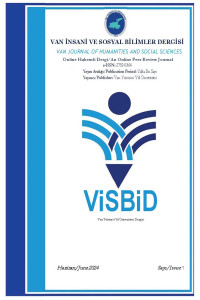Öz
Geçmiş birçok Türk-İslâm devletinde hükümdarların imzası niteliğinde olan tuğralar, aynı zamanda saltanatın alâmeti olarak da kabul edilmiştir. Tuğraların sahip olduğu bu önem nedeniyle yapımlarında belirli bir üslup çerçevesinde, estetik kaygının ön planda tutulduğu görülmektedir. Ancak Osmanlı’nın ilk dönemlerine ait tuğralar; gösterişten uzak şekilde düzenlenmekle beraber, II. Murat döneminden itibaren sanatsal hat yazılarına dönüştüğü anlaşılmaktadır. Tuğranın kolları üst tarafına yerleştirilen bitkisel motif ve kompozisyonlar tezyiniliğini artırmak için kullanılmıştır. Bitkisel süslemeler dışında, kolların üst tarafına bazı padişahların mahlas olarak adlandırılan takma adları da işlenmiştir. Ayrıca bazı tuğra örneklerinde tuğrayı çeken hattatın imzasının yer alması, bu örneklerin belge olma niteliğini pekiştirmektedir. Bu çalışmada İstanbul Deniz Müzesi’nde Geç Dönem Osmanlı padişahlarına ait ahşap levha tuğralar ele alınmıştır. İncelemeye konu olan bu levhalar oval biçimde yüzeyindeki tuğra ile birlikte bitkisel motiflerden oluşan süslemeleri ihtiva etmektedir. Ancak bu levhaların denizcilikte kullanılması nedeniyle, halat motiflerine de yer verildiği görülmüştür. Araştırmaya konu olan örneklerin denizlerde Osmanlı Devleti’nin gücünü ortaya koyan anlamlar içermesi açısından da önemi ortadadır. Böylece Batılılaşma Dönemi Osmanlı padişahlarına ait bazı levha tuğra örnekleri bu çalışmanın konusunu teşkil etmiştir.
Anahtar Kelimeler
Teşekkür
Bu yayının yapılmasında desteklerini esirgemeyen Yarbay Gökhan ATMACA beye teşekkürlerimi sunarım
Kaynakça
- Akkaya, T. (2001). “İstanbul Deniz Müzesi’’, Türkiye Diyanet Vakfı İslam Ansiklopedisi, 23, 304-305.
Öz
In many past Turkish-Islamic states, the tughra, which is the signature of the rulers, has also been accepted as a sign of sovereignty. Due to this importance of the tughras, it is seen that aesthetic concerns were prioritized within the framework of a certain style in their production. However, although the tughras of the early Ottoman period were arranged without ostentation, it is understood that they turned into artistic calligraphy from the reign of Murat II onwards. The floral motifs and compositions placed on the upper side of the arms of the tughra were used to increase its ornamentation. Apart from the floral ornaments, the nicknames of some sultans, called mahlas, were also engraved on the upper side of the arms. In addition, the signature of the calligrapher on some of the tughra examples reinforces the documentary quality of these examples. This study focuses on the wooden plate tughras of the late Ottoman sultans in the Istanbul Naval Museum. These plates, which are the subject of the study, contain decorations consisting of floral motifs together with the tughra on the oval-shaped surface. However, due to the use of these plates in maritime use, it was seen that rope motifs were also included. The importance of the examples subject to the research is evident in terms of the meanings that reveal the power of the Ottoman Empire in the seas. Thus, some examples of plate tughra belonging to the Ottoman sultans during the Westernization Period constitute the subject of this study.
Anahtar Kelimeler
Kaynakça
- Akkaya, T. (2001). “İstanbul Deniz Müzesi’’, Türkiye Diyanet Vakfı İslam Ansiklopedisi, 23, 304-305.
Ayrıntılar
| Birincil Dil | Türkçe |
|---|---|
| Konular | İslam Sanatları |
| Bölüm | Araştırma Makaleleri |
| Yazarlar | |
| Erken Görünüm Tarihi | 29 Haziran 2024 |
| Yayımlanma Tarihi | 30 Haziran 2024 |
| Gönderilme Tarihi | 14 Mayıs 2024 |
| Kabul Tarihi | 28 Haziran 2024 |
| Yayımlandığı Sayı | Yıl 2024 Sayı: 7 |
ViSBiD, MLA ve Crossref tarafından indekslenmektedir. Ayrıca Index Copernicus takip sistemine alınmıştır.


